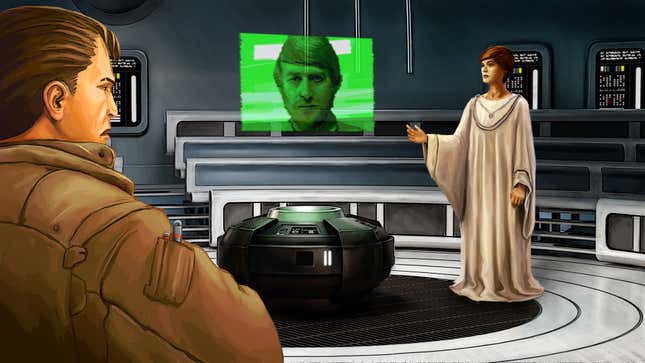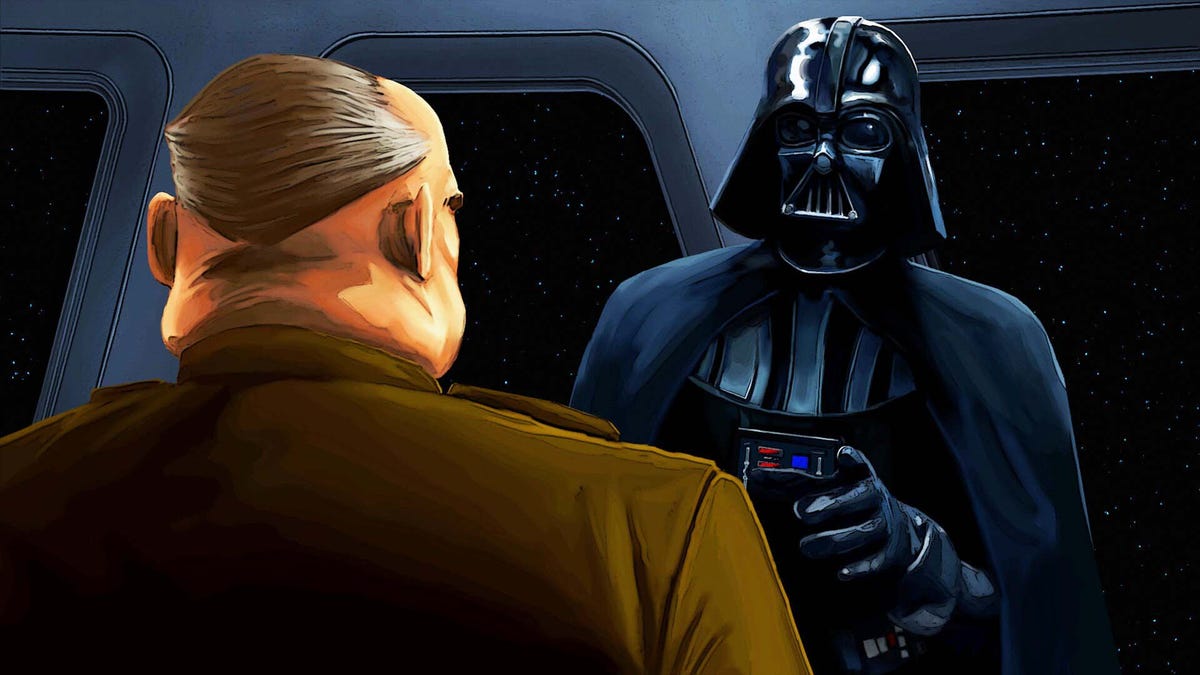First released back in 1995, Star Wars: Dark Forces is a first-person shooter that plays similarly to Doom, but included new (for the era) features—like rooms on top of rooms, looking up and down, and jumping—elevating it beyond a simple clone. It also had an original Star Wars story and introduced new, popular characters—like Kyle Katarn—and concepts like the Dark Troopers, which have continued to appear in Star Wars media, even showing up in The Mandalorian. In other words, it’s an important and very good Star Wars video game.
We’ve said before that Star Wars: Dark Forces is the most Star Wars-y game ever made and one of the best in the history of the franchise. Yet until today, folks wanting to revisit the game on modern systems had to use fan-created source ports like the Force Engine, which strives to rebuild LucasArts’ original Jedi Engine for current technology. These fan creations are great and remain a terrific way to play Dark Forces. Still, it felt like the game deserved a more official, bigger remaster. But now, with the February 28 release of Dark Forces Remaster, this classic LucasArts shooter has been ported to modern consoles and remastered to look and play better than ever, while still retaining the feel and charm that made the original game so special back in 1997.
I was able to play the game before release and chatted with some of the folks from Nightdive Studios—a team that has become famous for its work remastering and remaking classic games—to learn just how much work went into remastering such a beloved Star Wars game.
My first question is: why now? Why remaster and release Dark Forces in 2024? Larry Kuperman, Director of Business Development at Nightdive, told me that with all the other great Star Wars spin-offs and other projects happening now, it seemed like “the perfect time to share [Dark Forces] with today’s audience.”
Bringing a classic Star Wars game to consoles ain’t easy
But that’s easier said than done. The original game was built for DOS and ran at a much lower resolution than modern TV and PC monitors. Getting such an old PC game to work on Xbox, Switch, and PlayStation presented some challenges. However, Nightdive’s secret weapon is its versatile and flexible KEX Engine, which has been used in the past to act as a technological bridge between ancient video game engines and modern PCs and systems.
“For my money, the most difficult functionality to port was Dark Forces’ task system,” said Max Waine, the project lead and producer on Dark Forces Remastered. (Tasks control nearly every aspect of the game, including weapons and sprites.) “Samuel Villarreal (Lead KEX Engine developer at Nightdive) was the one who did that, moving over from the use of the DOS programmable timer to fibers. The system was very complex, and making it work on modern hardware using modern multithreading techniques without falling afoul of the classic threading issues was quite the ordeal.”
But it wasn’t just the nitty-gritty technical problems that proved tricky to overcome when remastering such an old PC shooter. Even the game’s menus provided a challenge, as they needed to be reworked to look better and feel better when playing with a gamepad. The team spent weeks just replacing the menus in Dark Forces with something that would be better-suited for the project.
Another iconic part of Dark Forces is the game’s cutscenes. Originally, these videos were created using a mix of assets—including screenshots from the films—and while it worked well in 1997, Nightdive realized that the remaster would have to figure out a way to unify the look of the cutscenes while retaining their feel.
“We found out pretty quickly that just recreating the scenes at a higher resolution only pulled more attention to how different each of these pieces felt,” explained Brendan McKinney, a cinematic artist on the remaster. “With Lucasfilm Games, we really pushed to embrace the mixed-medium spirit of the originals but also to narrow the divide so that even at higher resolution, everything fit comfortably together.”
McKinney said that it was another Nightdive artist, Ben Chandler, who led the charge on digitally painting all-new character art for folks like Crix Madine and Jabba the Hutt. Previously, these characters were represented in-game via stills from the actual movies. Meanwhile, McKinney himself re-created cutscene environments in 3D and then painted over them for “additional texture and shading.”
“Finally, for the space sequences, I just tried to keep them simple and match the feel of the original work. For those shots, we really need to give a shout-out to Daniel Andersson (a senior developer at Nightdive) as well, who worked on all of the fantastic ship models that filled those scenes,” said McKinney.
The end result, as someone who has played through the remaster already, is impressive. The cutscenes, along with the improved visuals in-game, all look like how you remember Dark Forces looking back in 1997.
What’s the difference between this and the fan port of Dark Forces?
Another question I had for Nightdive and Lucasfilm Games was how this professionally made and officially approved remaster of Dark Forces fits into the larger community around the game, who have been doing similar work for years now. Interestingly, the folks who worked on this game were quick to say they don’t see this project or their work as competing with fan mods and ports.
“I would certainly not use the word ‘competition’ to describe our relationship with The Force Engine,” said Waine. “LuciusDXL (a fan dev famous for their work on the Force Engine port of Dark Forces) was a great help in key aspects of our development process, and in turn, we were able to help here and there.”
Waine further explained that they were careful when remastering Dark Forces that any new data formats introduced in the new port wouldn’t cause future issues for The Force Engine down the line.
As for why a commercial remaster of Dark Forces is needed when fans have done such good work, Waine explained that fan remasters and official remasters both have “upsides and downsides.”
“A commercial project can commit more resources sooner to things like assets, get work done faster (due to having a full team working full-time), and officially release on consoles,” explained Waine. “Fan source ports are slower and steadier. They’ve no budget to worry about, no concerns of needing to make things work across all consoles; their main limit is the amount of free time the developers have.”

Another key difference between this new retail remaster of Dark Forces and a fan port: The Vault. This feature in the remastered game lets folks dig through old LucasArts content and artwork and provides info on the tools used to create the shooter. Not only that, the Vault includes a playable level that was only available at trade shows, letting folks get a taste of some lost Star Wars video game history. This was only possible thanks to help from Lucasfilm and Disney, who provided Nightdive access to items from their archives to use in the remaster, including original source assets and behind-the-scenes content for the Vault.
The devs told me that they felt a lot of pressure while working on something as beloved and important as Star Wars: Dark Forces. But it was also an “honor” to work on this project.
“It’s not every day that you’re permitted the opportunity to work with a venerated, storied, and important franchise as Star Wars. Doubly so for a game that’s as venerated, storied, and important as Dark Forces,” said Waine.
“There’s definitely a lot of pressure that comes from working on something so important—it was imperative we do the original game justice. What was truly a special experience was being able to look through the development depot for the game; I really hope that we’re able to bring that same feeling to fans with The Vault.”
Star Wars: Dark Forces Remaster is out now on Xbox, PlayStation, Switch, and PC.
.
